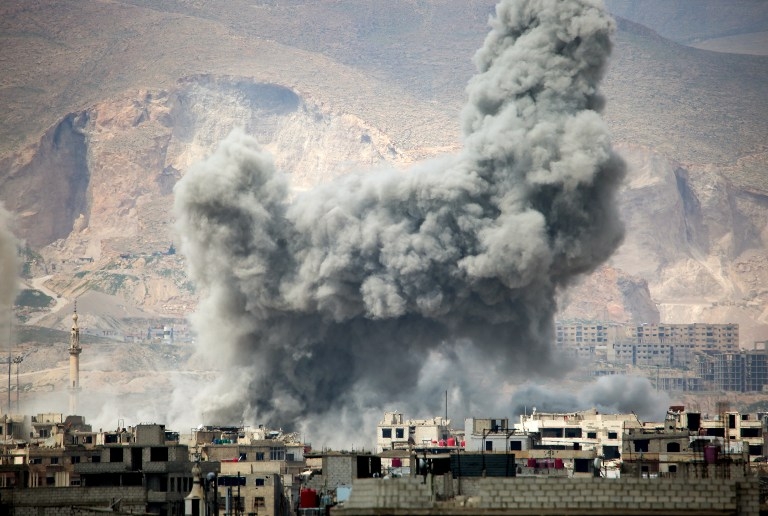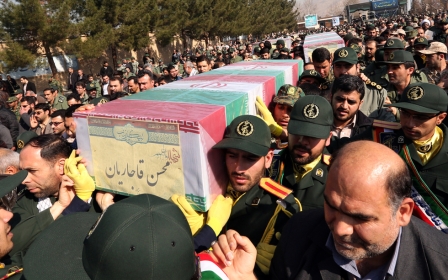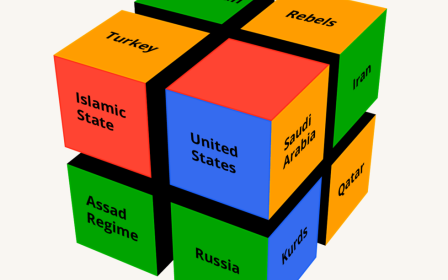Syria war: The recent attacks in Damascus are only the start

Against the backdrop of the Astana talks being boycotted by the armed Syrian opposition and the failed Geneva discussions, a wave of violence targeting regime areas heralds a new phase in the Syrian conflict.
A bombing and four suicide attacks targeting Damascus and Homs over the last month are signs that the hegemony of the Assad regime over a divided country will be marked by a growing number of terrorism incidents rather than any newfound stability.
The HTS narrative has been supported by events in Syria where deadly air strikes are ongoing, targeting populated areas despite a meek ceasefire
It started in January with a twin suicide bombing that targeted the security sensitive Kafr Sousa neighborhood in Damascus killing 11 people, including eight soldiers.
Less than a month later on 25 February, a series of suicide attacks hit military installations in the government-held western city of Homs killing 32, including Syrian military intelligence chief General Hassan Daabul, a close ally of President Bashar Assad. Brigadier Ibrahim Darwish, head of the State Security branch, was also wounded in the attack. The violence coincided with the second day of meetings in Geneva.
Two weeks later on 11 March, around 74 people - including 43 Iraqi Shia pilgrims - were killed in a double suicide bombing in Bab Saghir area in Damascus. The neighbourhood is home to several Shia shrines including the Sayyida Zeinab mausoleum which is one of Syria’s most visited Shia pilgrimage sites.
On 15 March, a suicide bomber triggered an explosion in the Palace of Justice in Damascus killing at least 31 and injuring 60. The courthouse bomber set off an explosive device as the police searched him. A few hours later, a second explosion hit a restaurant in al-Rabweh, injuring 20 people.
On Monday, a big explosion - most likely by a car blast - was followed by a large rebel incursion in the east Damascus area, two days before another round of UN-backed peace talks were set to get underway in Switzerland.
With the exception of Monday's explosion and the 15 March bombing, the attacks were all claimed by Hayaat Tahrir Sham ( HTS), a coalition of forces led by former Salafi-oriented members of Ahrar al-Sham who have recently defected and Jabhat Fateh al-Sham, a former al-Qaeda affiliate.
The utility of terrorism
These attacks underline two important trends. First, rebel groups, led by HTS, appear to be falling back on large-scale terror attacks as other military and negotiation options become less attractive.
Rebel tactics, which until last year were comprised for the most of guerilla and conventional warfare, are now devolving to terror bombings
While the Syrian war has been marked by suicide attacks, mostly at the hands of the Islamic State (IS) group and the Nusra Front, guerilla attacks and terror bombings in government-controlled territory may now become the preferred course of action for the opposition at large following major military setbacks.
Terrorism as a political tool is generally abandoned in three cases: when it has accomplished its purpose, when its utility declines or when new preferable alternatives are available, according to terror expert Martha Crenshaw, a senior fellow at the Freeman Spogli Institute and the Center for International Security and Cooperation at Stanford University.
None of these cases apply to Syria’s reality today where the failure of dialogue is resulting in renewed violence. Rebel tactics, which until last year were comprised for the most of guerilla and conventional warfare, are now devolving to terror bombings, as the opposition margin of manoeuvre is increasingly constrained.
The utility of terrorism will be seen as more effective in the ranks of the weakened and divided opposition, struggling against a regime strong enough to win the main military theatres, but too weak to impose any sort of durable peace.
Negotiate or terrorise?
The second trend is HTS's dominance of the terror scene. Syria’s armed opposition and specifically its largest components - Ahrar al-Sham, Jaish al-Islam, and the Free Syrian Army - are under significant pressure from regional and international states to negotiate with the regime.
On the other hand, HTS, which has had more leeway, has insisted that the only option for opposition is terror and military warfare.
The HTS narrative has been supported by events in Syria where deadly air strikes are ongoing, targeting populated areas despite a meek ceasefire. HTS's policy of targeting the regime in its Damascus centre has bolstered its credibility as well as its popularity.
The bombing on Monday, followed by the rebel attacks in Jobar and Qaboun, underline a reprioritisation of the opposition fight against the regime and its attempts to catch up with HTS guerilla efforts.
In such a framework, terror attacks ranging from suicide bombers to car blasts will likely be the tool of choice, targeting mostly military and government institutions and Shia holy sites.
Terror attacks instill so much fear because they are erratic and indiscriminate, while offering benefits at a low cost for their perpetrators. For a weakened Syrian opposition, they will likely once again be the weapon of choice.
- Mona Alami is a researcher and journalist covering Levant politics. She is a non-resident-fellow at the Atlantic Council. Her primary focus is radical organisations. She holds a BA and an MBA in management.
The views expressed in this article belong to the author and do not necessarily reflect the editorial policy of Middle East Eye.
Photo: Smoke billows following a reported air strike in the rebel-held parts of the Jobar district, on the eastern outskirts of the Syrian capital Damascus, on 20 March 2017 (AFP)
This article is available in French on Middle East Eye French edition.
Middle East Eye propose une couverture et une analyse indépendantes et incomparables du Moyen-Orient, de l’Afrique du Nord et d’autres régions du monde. Pour en savoir plus sur la reprise de ce contenu et les frais qui s’appliquent, veuillez remplir ce formulaire [en anglais]. Pour en savoir plus sur MEE, cliquez ici [en anglais].





